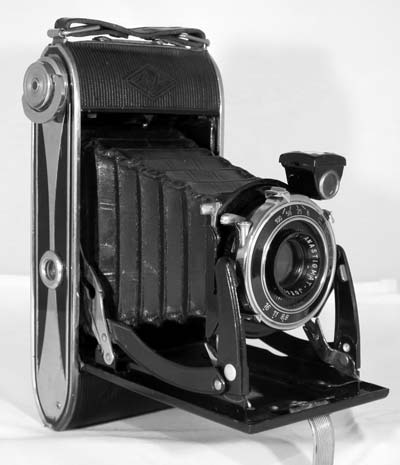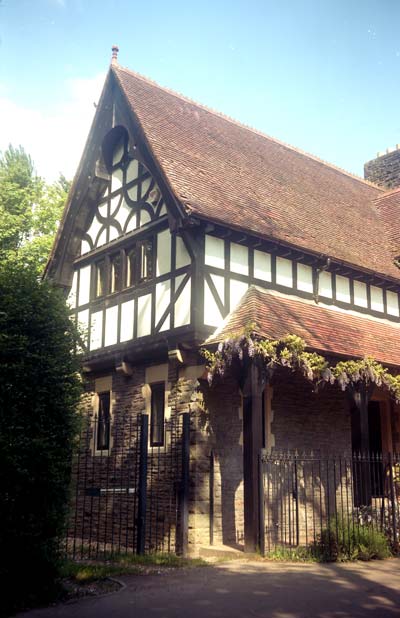Agfa Billy Record 8.8
Specification

| Manufacturer | : | Agfa |
|---|---|---|
| Produced | : | 1936 - 1942 |
| Classification | : | Medium Format |
| Body Type | : | Folding Bed |
| Bellows Deployment | : | Self Erecting |
| Construction | : | Metal |
| Film Size | : | 120 |
| Film width | : | 62mm |
| Image Size | : | 6 x 9 cm |
| No. of Images | : | 8 |
| Lens Type | : | Jgestar |
| Focal Length | : | 100mm |
| Focus Type | : | two position |
| Focal Range | : | 6-16ft & 16ft-inf. |
| Aperture Type | : | Iris |
| Apertures | : | f/8.8 - f/16 |
| Shutter Type | : | Agfa-Automat |
| Shutter Speeds | : | T,B, I(1/25, 1/50, 1/100 s) |
| Size Open (w x h x d) | : | 80 x 155 x 126 mm |
| Size Closed (w x h x d) | : | 80 x 155 x 32 mm |
| Weight | : | 540g |
Art Deco Credentials
![]()
![]()
![]()
![]()
Significant: Pronounced and self evident
- Produced during the main Art Deco period.
- Symmetrical geometric design on side panels.
- Raised chrome strips and glossy black enamel on side panels.
- Chrome on struts.
- Giraffe skin pattern on black struts.
- Subtle sunburst pattern around lens.
- Striped chevron pattern on black Rexine covering.
- Concentric circles on film winder.
- Striped detailing on chrome table stand.
- Chrome embellishments.
- Ribbing on viewfinder
- Agfa rhombus logo imprinted on body Rexine.
Description
The Agfa Billy Record 8.8 is a vertical folding camera, made by Agfa from 1936 to 1942. It makes eight 6x9cm pictures on 120 roll film. This camera is one of a series having similar external characteristics produced between 1932 and 1942. Other version featured apertures of f/4.5, f/6.3 and f/7.7.
The camera is capable of three speeds - 1/25s, 1/50s and 1/100s - as well as a bulb setting. A lever is provided to hold the shutter in the bulb setting if required. There is also a socket to fix a cable release. The aperture is controlled by an iris that is variable between f/16 and f/8.8. There is a two point focus adjustment allowing for focus ranges 2-5m and 5m-infinity.
Film advance is via a knob and is not coupled to the shutter release. Frame advance is via red window which is provided with a cover. Picture framing can be achieved by either using the fixed pop-up frame on the body or via the brilliant reflex viewfinder fixed to the lens plate. This is a well-built and substantial camera.
How to Use
This camera takes 120 film which easily available from photographic outlets.
Shutter speeds are 1/25s, 1/50s and 1/100s although the accuracy is not guaranteed. The aperture range is f/8.8 to f/16
If you don't want to bother with an exposure meter, follow the guide shown. It is based on the 'Sunny 16' rule. Film is so forgiving and will produce acceptable results even when overexposed by 1 or 2 stops or underexposed by 1 stop.
Remember that the exposure guide in the camera user manual may not be helpful as it is based on the use of old film with a low ISO value.
The tables assume that the sun is at least 30 degrees above the horizon - that's 10am - 5pm on a summer's day (May-August) in the UK.
If you are not sure about the light level, err on the side of overexposure - i.e. assume the smaller f number.
Where there is a choice, a larger f number will give a larger depth of field.
For the slower speeds, you may need a tripod to stop blur through shake.
Using ISO 100/125
Key: Green - Good exposure; Amber - acceptable exposure; Red - unacceptable exposure. Number of stops over or under shown.
| Weather Conditions | Shadow Detail | Shutter Speed (s) | ||
|---|---|---|---|---|
| 1/25 | 1/50 | 1/100 | ||
 Sunny SunnySnow/Sand | Dark with sharp edges | f/16 +3 over | f/16 +2 over | f/16 +1 over |
 Sunny Sunny | Distinct | f/16 +2 over | f/16 +1 over | f/16 |
 Slight Overcast Slight Overcast | Soft around edges | f/16 +1 over | f/16 | f/11 |
 Overcast Overcast | Barely visible | f/16 | f/11 | f/8.8 |
 Heavy Overcast Heavy Overcast | None | f/11 | f/8.8 | f/8.8 -1 under |
 Open Shade Open Shade/Sunset | None | f/8.8 | f/8.8 -1 under | f/8.8 -2 under |
Photographs taken with this Camera
Kodak Portra 160 film. Developed in Tenenal. Forgot to clean the lens. D'oh!



